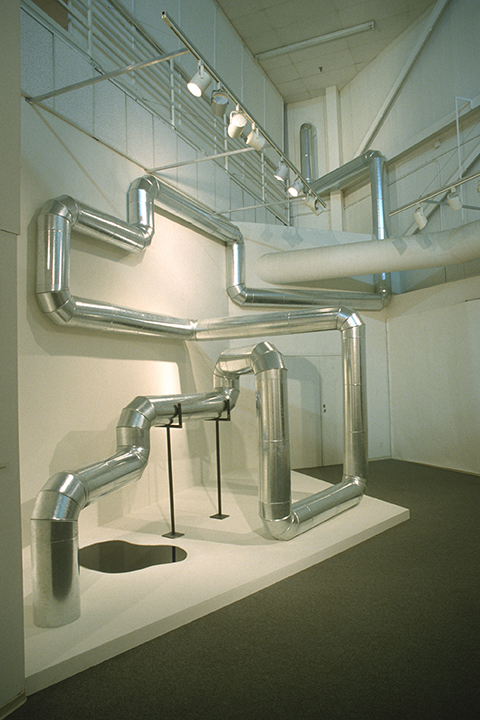 When planning for an exhibition that brings living—or recently living—materials into gallery spaces, there are preventive steps conservators must take to ensure certain elements of nature are not unwittingly let into the museum.
When planning for an exhibition that brings living—or recently living—materials into gallery spaces, there are preventive steps conservators must take to ensure certain elements of nature are not unwittingly let into the museum.
The artworks featured in Groundswell: Women of Land Art have given us the opportunity to employ long-practiced methods while also requiring head-scratching team planning. Confirming the weight capacity of our floors before installing heavy works composed of earth is an example of applying known fundamentals, while controlling the seemingly uncontrolled drip of oil seeping from Nancy Holt’s Pipeline (1986) took some imagination.
In the months leading up to installation, those of us involved in facilitating the tangibles of an exhibition have been working through exciting puzzles. In many instances, this has been in the re-creation of ephemeral artworks that bring the land inside.
The ecosystems in which land artworks have been conceived rely on thriving flora, fauna, and funga, but we of course cannot invite wood-boring beetles or mold spores into the building. How we weed out invasive elements from complex artworks is nuanced and imperfect, but necessary for the safety of other artworks in the building.
The steps taken when bringing wood (and other organic materials like wool, silk, leather, and bone) into the building include risk assessment, treatment for insects, and inspection for possible biological overgrowth. While it’s true that many wood-based artworks at the Nasher go through this process, artworks composed of industrially prepared wood—plywood and other lumber, for example—are pretreated and therefore aren’t prone to infestation.
Methods for treating materials usually employ extremes that can cause damage to complex compositions. The most material-friendly (but often cost-prohibitive) pest treatment method is anoxia, or the removal of oxygen from a sealed environment. The most common method is freezing. While less expensive and more accessible, freezing carries risks like moisture build-up unless using a high-quality system. Finally, the least popular method for pest eradication within artwork is through high temperature exposure. This is less common because damage can occur when naturally hydrophilic wood loses moisture quickly and contracts multi-directionally. This can cause wood to split and crack; extreme heat can also damage other materials used in a complex composition.
Sourcing materials to re-create Maren Hassinger’s Blanket of Branches, originally made in 1986, was a delightfully local process; branches were initially set aside by the Nasher’s facilities team after tree maintenance in the sculpture garden. Using freshly sourced materials meant considering the precautions mentioned above. However, because the collected branches were needed only temporarily for an installation, I considered broader methods to ensure the branches were pest-free.
In a presentation I attended at a recent conference, a conservator smartly explored “baking” wood materials she had sourced for a similar, temporary artwork. Wrapped in black plastic, the materials inside of the package crept over 100°F sitting in the sun—in Pittsburgh. When compared to the two weeks needed when freezing materials, just a few minutes at 120°F can eradicate wood-boring insects like beetles, carpenter ants, and termites. In Dallas we can easily reach this temperature within personal vehicles. By bagging our branches and setting them in the sun, we can quickly treat the large amount needed for this expansive artwork.
I never would have guessed that the Dallas heat could be a welcome tool in my arsenal, nor that I would be anticipating hot summer days for artwork preparation outside.
Editor’s note: As an extra precaution, the Dallas Museum of Art let us freeze the sticks in their walk-in freezer.
Image credits:
Nancy Holt (1938–2014). Pipeline, 1986. Visual Arts Center of Alaska, Anchorage [permanently closed, 1992]. Steel, oil. Overall dimensions: 30 x 32 x 15 ft. (9.1 x 9.8 x 4.6 m) (indoor section); 26 x 15 x 6 ft. (7.9 x 4.6 x 1.8 m) (outdoor section #1); 10 x 31 x 18 ft. (3 x 9.5 x 5.5 m) (outdoor section #2). © 2023 Holt/Smithson Foundation / Licensed by Artists Rights Society, New York
Photo of collected sticks that were found unusable due to the presence of termites. Photo: Adrienne Lichliter-Hines.
Photos of branches collected and stored for Maren Hassinger’s Blanket of Branches (1986). Photos: Adrienne Lichliter-Hines